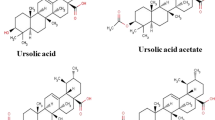Abstract
There is a growing interest in the use of botanical insecticides to reduce the use of synthetic pesticides in order to avoid environmental side effects. Anopheles stephensi is the primary vector of urban malaria, an endemic disease in India. So, an effort to assay An. stephensi larvae with gall extracts of Quercus infectoria was made under laboratory conditions at Mysore. Ethyl-acetate extract was found to be the most effective of all the five extracts tested for larvicidal activity against the fourth instar larvae, with LC50 of 116.92 ppm followed by gallotannin, n-butanol, acetone, and methanol with LC50 values of 124.62, 174.76, 299.26, and 364.61 ppm, respectively. The efficacy in killing mosquito larvae may make this plant promising for the development of new botanical larvicide.

Similar content being viewed by others
References
Burfield T, Reekie SL (2005) Mosquitoes, malaria and essential oils. Int J Aroma 15:30–41
Finney DJ (1971) Probit Analysis, 3rd edn. Cambridge University Press, Cambridge
Gallup JL, Sachs JD (2001) The economic burden of malaria. Am J Trop Med Hyg 64:85–96
Gayathri V, Balakrishna Murthy P (2006) Reduced susceptibility to deltamethrin and kdr mutation in Anopheles stephensi Liston, a malaria vector in India. J Am Mosq Cont Assoc 22:678–688
Gericke A, Govere JM, Durrheim DN (2002) Insecticide susceptibility in the South African malaria mosquito Anopheles arabiensis (Diptera: Culicidae). S Afr J Sc 98:205–208
Gubler DJ (1998) Resurgent vector-borne diseases as a global health problem. Emerg Infect Dis 4:442–450
Hargreaves K, Koekemoer LL, Brooke BD, Hunt RH, Mthembu J, Coetzee M (2000) Anopheles funestus resistant to pyrethroid insecticides in South Africa. Med Vet Entomol 14:181–189
Killeen GF, Fillinger U, Knols BG (2002) Advantages of larval control for African malaria vectors: low mobility and behavioural responsiveness of immature mosquito stages allow high effective coverage. Malar J 1:8
Maurya P, Mohan L, Sharma P, Batabyal L, Srivastava CN (2007) Larvicidal efficacy of Aloe barbadensis and Cannabis sativa against the malaria vector Anopheles stephensi (Diptera: Culicidae). Entomol Res 37:153–156
Mulla MS, Su T (1999) Activity and biological effects of neem products against arthropods of medical and veterinary importance. J Am Mosq Cont Assoc 15:133–152
Muturi EJ, Burgess P, Novak RJ (2008) Malaria vector management: where have we come from and where are we headed? Am J Trop Med Hyg 78:536–537
National Vector Borne Disease Control Programme (NVBDCP) (2008) Malaria, magnitude of the problem. Available at http://www.nvbdcp.gov.in/malaria3.html Accessed on May 25, 2008
Ranson H, Rossiter L, Ortelli F, Jensen B, Wang X, Roth CW, Collins FH, Hemingway J (2001) Identification of a novel class of insect glutathione S-transferases involved in resistance to DDT in the malaria vector, Anopheles gambie. Biochem J 359:295–304
Redwane A, Lazrek HB, Bouallam S, Markouk M, Amarouch H, Jana M (2002) Larvicidal activity of extracts from Quercus lusitania var. infectoria galls (Oliv.). J Ethnopharmacol 79:261–263
Sachs J, Malaney P (2002) The economic and social burden of malaria. Nature 415:680–685
Shaalan EA, Canyon D, Younes MW, Abdel-Wahab H, Mansour AH (2005) A review of botanical phytochemicals with mosquitocidal potential. Environ Int 31:1149–1166
Sharma P, Mohan L, Srivastava CN (2006) Impact analysis of neem kernel extracts on the developmental profile of Anopheles stephensi. J Asia Pac Entomol 9:11–17
Shelton AM, Wang P, Zhao J-Z, Roush RT (2007) Resistance to insect pathogens and strategies to manage resistance: An update. In: Laceyand LA, Kaya HK (eds) Field Manual of Techniques in Invertebrate Pathology. Springer-Verlag, New York
Sukumar K, Perich MJ, Boobar LR (1991) Botanical derivatives in mosquito control: a review. J Am Mosq Cont Assoc 7:210–237
Taubes G (1997) A mosquito bites back. New York Times Magazine 24 Aug: 40–46
Tavakoli M, Melika G, Sadeghi SE, Penzes Z, Assareh MA, Atkinson R, Bechtol M, Miko I, Zargaran MR, Aligolizade D, Barimani H, Bihari P, Pirozi F, Fulop D, Somogyi K, Challis R, Preuss S, Nicholls J, Stone GN (2008) New species of oak gall wasps from Iran (Hymenoptera: Cynipidae: Cynipini). Zootaxa 1699:1–64
Trivedy RK, Goel PK (1986) Chemical and biological methods for water pollution studies. Environmental Publications, Karad
Umachigi SP, Jayaveera KN, Ashok Kumar CK, Kumar GS, Vrushabendra swamy BM, Kishore Kumar DV (2008) Studies on wound healing properties of Quercus Infectoria. Trop J Pharm Res 7:913–919
World Health Organization (1981) Instructions for determining the susceptibility or resistance of mosquito larvae to insecticides. WHO, Geneva WHO/VBC/81.807
World Health Organization (2005) World malaria report 2005. WHO, Geneva Available at www.rollbackmalaria.org/wmr2005/pdf/WMReport_lr.pdf
World Health Organization study group (2006) Malaria vector control and personal protection. WHO Tech Rep Ser 936:1–62
Zaim M, Guillet P (2002) Alternative insecticides: an urgent need. Trends Parasitol 18:161–163
Acknowledgement
The authors are grateful to the Chairman, DOS in Zoology, University of Mysore, for providing necessary facilities. We also kindly thank Mr. Majid Tavakoli, researcher, Lorestan Agricultural and Natural Resources Research Center, Khoramabad, Lorestan, Iran, for collecting, identifying, and providing oak gall samples. First author is thankful to Ilam Medical Sciences University, Iran, for financial support.
Author information
Authors and Affiliations
Corresponding author
Rights and permissions
About this article
Cite this article
Aivazi, AA., Vijayan, V.A. Larvicidal activity of oak Quercus infectoria Oliv. (Fagaceae) gall extracts against Anopheles stephensi Liston. Parasitol Res 104, 1289–1293 (2009). https://doi.org/10.1007/s00436-008-1325-5
Received:
Accepted:
Published:
Issue Date:
DOI: https://doi.org/10.1007/s00436-008-1325-5



